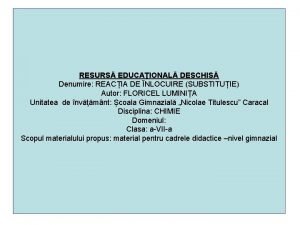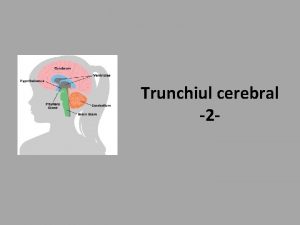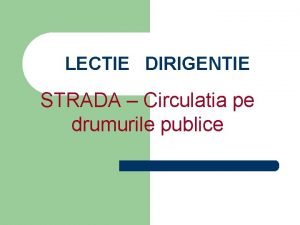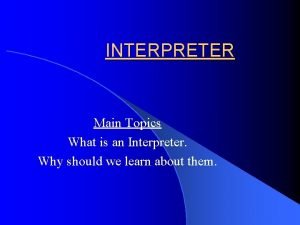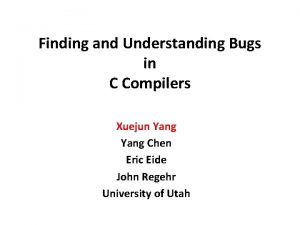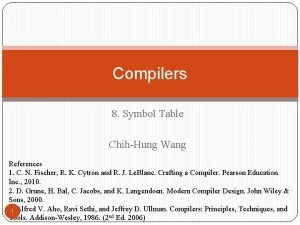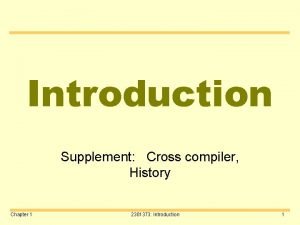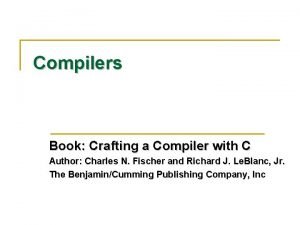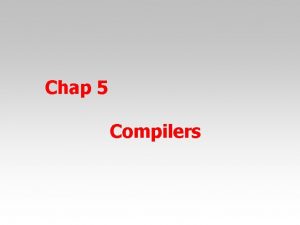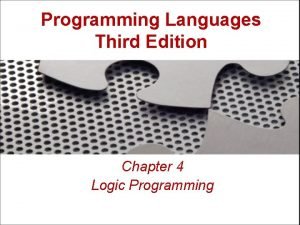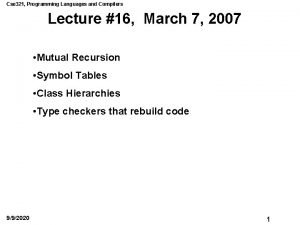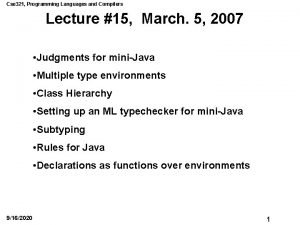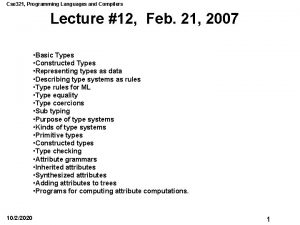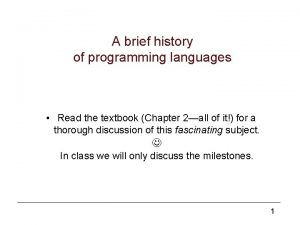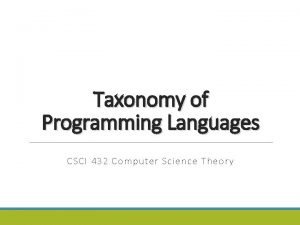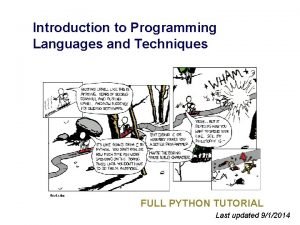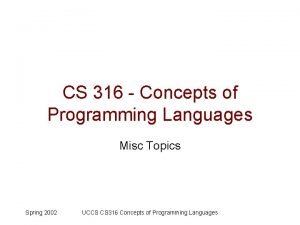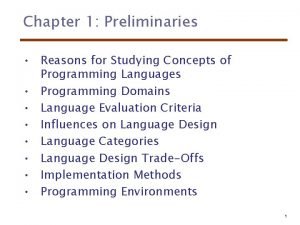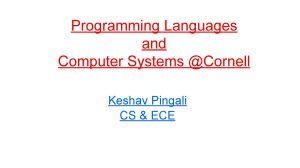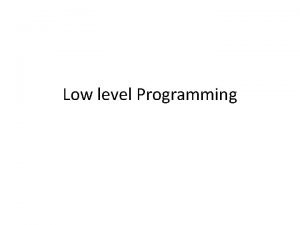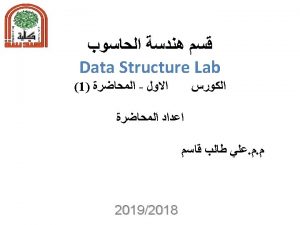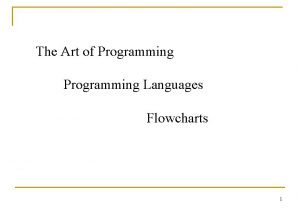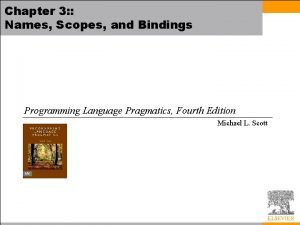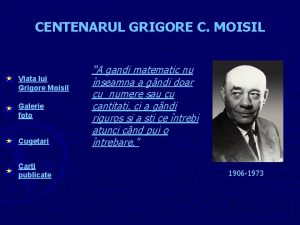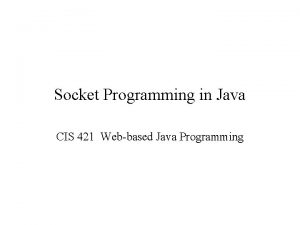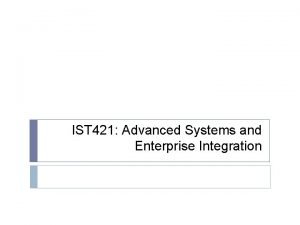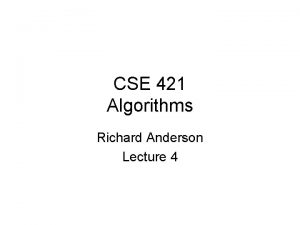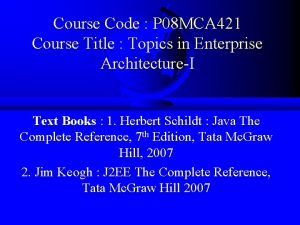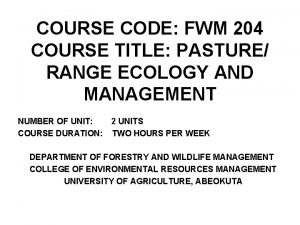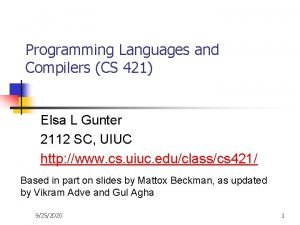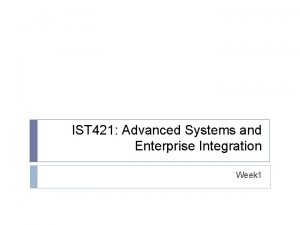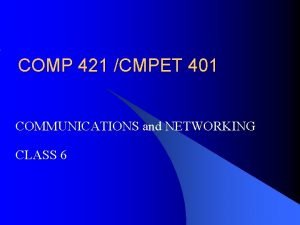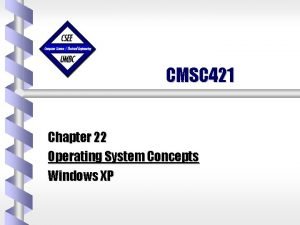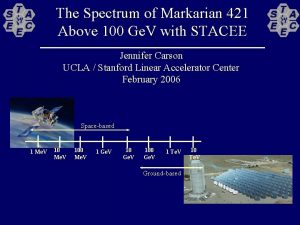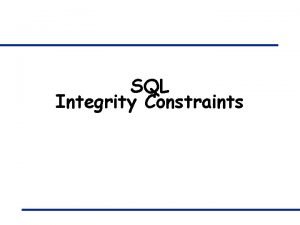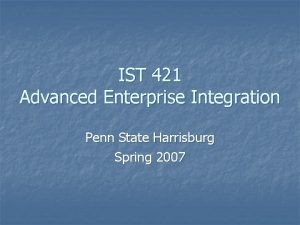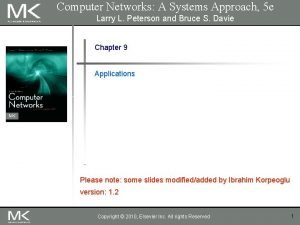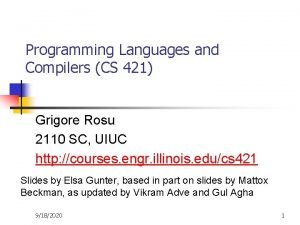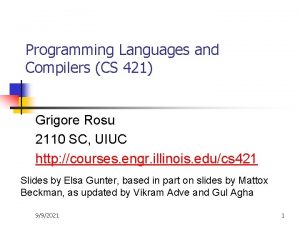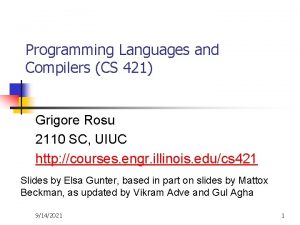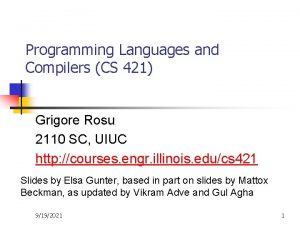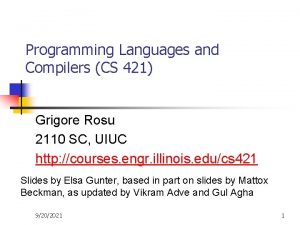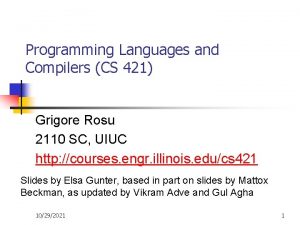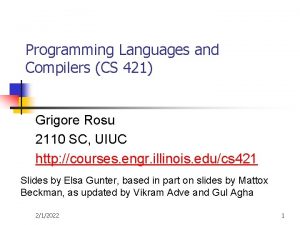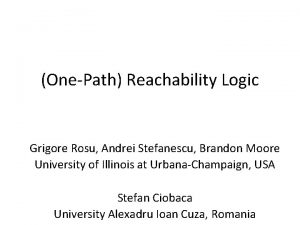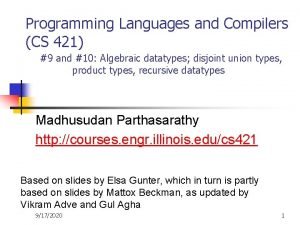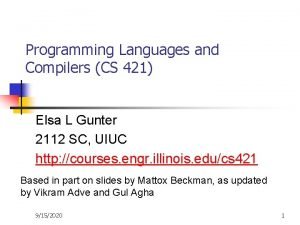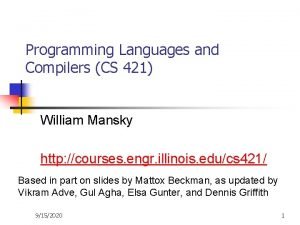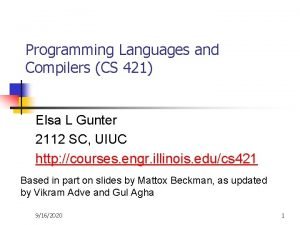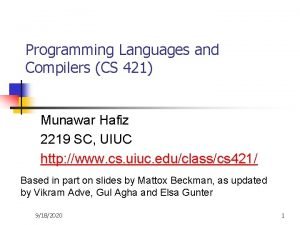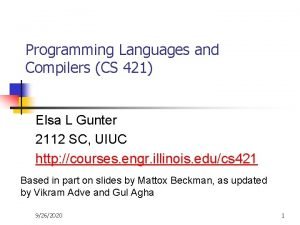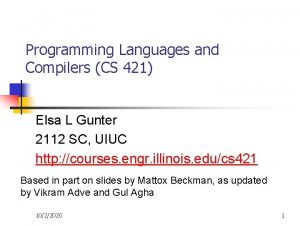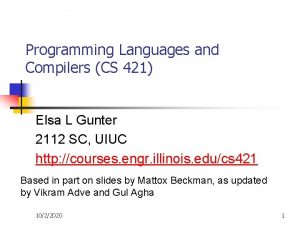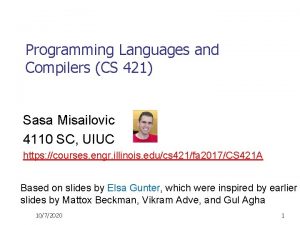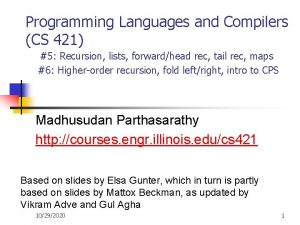Programming Languages and Compilers CS 421 Grigore Rosu






![Ocamllex Regular Expression [c 1 - c 2]: choice of any character between first Ocamllex Regular Expression [c 1 - c 2]: choice of any character between first](https://slidetodoc.com/presentation_image_h2/4b7e3fca5f3ab399af5d81fe225d7ba8/image-7.jpg)










![Dealing with comments | open_comment { comment lexbuf} | eof { [] } | Dealing with comments | open_comment { comment lexbuf} | eof { [] } |](https://slidetodoc.com/presentation_image_h2/4b7e3fca5f3ab399af5d81fe225d7ba8/image-18.jpg)


























































- Slides: 76

Programming Languages and Compilers (CS 421) Grigore Rosu 2110 SC, UIUC http: //courses. engr. illinois. edu/cs 421 Slides by Elsa Gunter, based in part on slides by Mattox Beckman, as updated by Vikram Adve and Gul Agha 1/2/2022 1

Objective n n n Finish the discussion on lexing Ocamllex (takes. mll files and generates. ml) Context-Free Grammars and BNF 1/2/2022 2

General Input for. mll Files { header } let ident = regexp. . . rule entrypoint [arg 1. . . argn] = parse regexp { action } |. . . | regexp { action } and entrypoint [arg 1. . . argn] = parse. . . and. . . { trailer } 1/2/2022 3

Ocamllex Input n n header and trailer contain arbitrary ocaml code put at top an bottom of <filename>. ml let ident = regexp. . . Introduces ident for use in later regular expressions 1/2/2022 4

Ocamllex Input n <filename>. ml contains one lexing function per entrypoint n n n Name of function is name given for entrypoint Each entry point becomes an Ocaml function that takes n +1 arguments, the extra implicit last argument being of type Lexing. lexbuf arg 1. . . argn are for use in action 1/2/2022 5

Ocamllex Regular Expression Single quoted characters for letters: ‘a’ n _: (underscore) matches any letter n Eof: special “end_of_file” marker n Concatenation same as usual n “string”: concatenation of sequence of characters n e 1 | e 2 : choice - what was e 1 e 2 n 1/2/2022 6
![Ocamllex Regular Expression c 1 c 2 choice of any character between first Ocamllex Regular Expression [c 1 - c 2]: choice of any character between first](https://slidetodoc.com/presentation_image_h2/4b7e3fca5f3ab399af5d81fe225d7ba8/image-7.jpg)
Ocamllex Regular Expression [c 1 - c 2]: choice of any character between first and second inclusive, as determined by character codes n [^c 1 - c 2]: choice of any character NOT in set n e*: same as before n e+: same as e e* n e? : option - was e 1 n 1/2/2022 7

Ocamllex Regular Expression n e 1 # e 2: the characters in e 1 but not in e 2; e 1 and e 2 must describe just sets of characters n ident: abbreviation for earlier reg exp in let ident = regexp n e 1 as id: binds the result of e 1 to id to be used in the associated action 1/2/2022 8

Ocamllex Manual n More details can be found at http: //caml. inria. fr/pub/docs/manualocaml/lexyacc. html 1/2/2022 9

Example : test. mll { type result = Int of int | Float of float | String of string } let digit = ['0'-'9'] let digits = digit + let lower_case = ['a'-'z'] let upper_case = ['A'-'Z'] letter = upper_case | lower_case letters = letter + 1/2/2022 10

Example : test. mll rule main = parse (digits)'. 'digits as f { Float (float_of_string f) } | digits as n { Int (int_of_string n) } | letters as s { String s} | _ { main lexbuf } { let newlexbuf = (Lexing. from_channel stdin) in print_string "Ready to lex. "; print_newline (); main newlexbuf } 1/2/2022 11

Example #use "test. ml"; ; … val main : Lexing. lexbuf -> result = <fun> val __ocaml_lex_main_rec : Lexing. lexbuf -> int -> result = <fun> Ready to lex. hi there 234 5. 2 - : result = String "hi" What happened to the rest? !? 1/2/2022 12

Example # let b = Lexing. from_channel stdin; ; # main b; ; hi 673 there - : result = String "hi" # main b; ; - : result = Int 673 # main b; ; - : result = String "there" 1/2/2022 13

Problem n n How to get lexer to look at more than the first token at one time? Answer: action has to tell it to -- recursive calls Side Benefit: can add “state” into lexing Note: already used this with the _ case 1/2/2022 14

Example rule main = parse (digits) '. ' digits as f { Float (float_of_string f) : : main lexbuf} | digits as n { Int (int_of_string n) : : main lexbuf } | letters as s { String s : : main lexbuf} | eof { [] } |_ { main lexbuf } 1/2/2022 15

Example Results Ready to lex. hi there 234 5. 2 - : result list = [String "hi"; String "there"; Int 234; Float 5. 2] # Used Ctrl-d to send the end-of-file signal 1/2/2022 16

Dealing with comments First Attempt let open_comment = "(*" let close_comment = "*)" rule main = parse (digits) '. ' digits as f { Float (float_of_string f) : : main lexbuf} | digits as n { Int (int_of_string n) : : main lexbuf } | letters as s { String s : : main lexbuf} 1/2/2022 17
![Dealing with comments opencomment comment lexbuf eof Dealing with comments | open_comment { comment lexbuf} | eof { [] } |](https://slidetodoc.com/presentation_image_h2/4b7e3fca5f3ab399af5d81fe225d7ba8/image-18.jpg)
Dealing with comments | open_comment { comment lexbuf} | eof { [] } | _ { main lexbuf } and comment = parse close_comment { main lexbuf } |_ { comment lexbuf } 1/2/2022 18

Dealing with nested comments rule main = parse … | open_comment { comment 1 lexbuf} | eof { [] } | _ { main lexbuf } and comment depth = parse open_comment { comment (depth+1) lexbuf } | close_comment { if depth = 1 then main lexbuf else comment (depth - 1) lexbuf } |_ { comment depth lexbuf } 1/2/2022 19

Dealing with nested comments rule main = parse (digits) '. ' digits as f { Float (float_of_string f) : : main lexbuf} | digits as n { Int (int_of_string n) : : main lexbuf } | letters as s { String s : : main lexbuf} | open_comment { (comment 1 lexbuf} | eof { [] } | _ { main lexbuf } 1/2/2022 20

Dealing with nested comments and comment depth = parse open_comment { comment (depth+1) lexbuf } | close_comment { if depth = 1 then main lexbuf else comment (depth - 1) lexbuf } |_ { comment depth lexbuf } 1/2/2022 21

Types of Formal Language Descriptions n n Regular expressions, regular grammars Context-free grammars, BNF grammars, syntax diagrams Finite state automata Whole family more of grammars and automata – covered in automata theory 1/2/2022 22

Sample Grammar n n n Language: Parenthesized sums of 0’s and 1’s <Sum> : : = <Sum >: : = <Sum> : : = 1/2/2022 0 1 <Sum> + <Sum> (<Sum>) 23

BNF Grammars n Start with a set of characters, a, b, c, … n n Add a set of different characters, X, Y, Z, … n n We call these terminals We call these nonterminals One special nonterminal S called start symbol 1/2/2022 24

BNF Grammars n n BNF rules (aka productions) have form X : : = y where X is any nonterminal and y is a string of terminals and nonterminals BNF grammar is a set of BNF rules such that every nonterminal appears on the left of some rule 1/2/2022 25

Sample Grammar n n n Terminals: 0 1 + ( ) Nonterminals: <Sum> Start symbol = <Sum> : : = 0 n <Sum >: : = 1 n <Sum> : : = <Sum> + <Sum> n <Sum> : : = (<Sum>) n Can be abbreviated as <Sum> : : = 0 | 1 | <Sum> + <Sum> | (<Sum>) n 1/2/2022 26

BNF Deriviations Given rules X: : = y Zw and Z : : =v we may replace Z by v to say X => y Zw => yvw n Sequence of such replacements called n derivation n Derivation called right-most if always replace the right-most non-terminal 1/2/2022 27

BNF Derivations n Start with the start symbol: <Sum> => 1/2/2022 28

BNF Derivations n Pick a non-terminal <Sum> => 1/2/2022 29

BNF Derivations Pick a rule and substitute: n <Sum> : : = <Sum> + <Sum> => <Sum> + <Sum > n 1/2/2022 30

BNF Derivations n Pick a non-terminal: <Sum> => <Sum> + <Sum > 1/2/2022 31

BNF Derivations Pick a rule and substitute: n <Sum> : : = ( <Sum> ) <Sum> => <Sum> + <Sum > => ( <Sum> ) + <Sum> n 1/2/2022 32

BNF Derivations n Pick a non-terminal: <Sum> => <Sum> + <Sum > => ( <Sum> ) + <Sum> 1/2/2022 33

BNF Derivations Pick a rule and substitute: n <Sum> : : = <Sum> + <Sum> => <Sum> + <Sum > => ( <Sum> ) + <Sum> => ( <Sum> + <Sum> ) + <Sum> n 1/2/2022 34

BNF Derivations n Pick a non-terminal: <Sum> => <Sum> + <Sum > => ( <Sum> ) + <Sum> => ( <Sum> + <Sum> ) + <Sum> 1/2/2022 35

BNF Derivations Pick a rule and substitute: n <Sum >: : = 1 <Sum> => <Sum> + <Sum > => ( <Sum> ) + <Sum> => ( <Sum> + 1 ) + <Sum> n 1/2/2022 36

BNF Derivations n Pick a non-terminal: <Sum> => <Sum> + <Sum > => ( <Sum> ) + <Sum> => ( <Sum> + 1 ) + <Sum> 1/2/2022 37

BNF Derivations Pick a rule and substitute: n <Sum >: : = 0 <Sum> => <Sum> + <Sum > => ( <Sum> ) + <Sum> => ( <Sum> + 1 ) + 0 n 1/2/2022 38

BNF Derivations n Pick a non-terminal: <Sum> => <Sum> + <Sum > => ( <Sum> ) + <Sum> => ( <Sum> + 1 ) + 0 1/2/2022 39

BNF Derivations Pick a rule and substitute n <Sum> : : = 0 <Sum> => <Sum> + <Sum > => ( <Sum> ) + <Sum> => ( <Sum> + 1 ) 0 => ( 0 + 1 ) + 0 n 1/2/2022 40

BNF Derivations n ( 0 + 1 ) + 0 is generated by grammar <Sum> => <Sum> + <Sum > => ( <Sum> ) + <Sum> => ( <Sum> + 1 ) + 0 => ( 0 + 1 ) + 0 1/2/2022 41

<Sum> : : = 0 | 1 | <Sum> + <Sum> | (<Sum>) <Sum> => 1/2/2022 42

BNF Semantics n The meaning of a BNF grammar is the set of all strings consisting only of terminals that can be derived from the Start symbol 1/2/2022 43

Regular Grammars n n Subclass of BNF Only rules of form <nonterminal>: : =<terminal><nonterminal> or <nonterminal>: : =<terminal> or <nonterminal>: : =ε Defines same class of languages as regular expressions Important for writing lexers (programs that convert strings of characters into strings of tokens) 1/2/2022 44

Example n n Regular grammar: <Balanced> : : = 0 <One. And. More> <Balanced> : : = 1 <Zero. And. More> <One. And. More> : : = 1 <Balanced> <Zero. And. More> : : = 0 <Balanced> Generates even length strings where every initial substring of even length has same number of 0’s as 1’s 1/2/2022 45

Extended BNF Grammars n n n Alternatives: allow rules of from X : : = y | z n Abbreviates X : : = y, X : : = z Options: X : : = y [v ] z n Abbreviates X : : = yvz, X : : = yz Repetition: X : : =y {v }* z n Can be eliminated by adding new nonterminal V and rules X : : =yz X : : = y. Vz V : : = v V 1/2/2022 46

Parse Trees n n Graphical representation of derivation Each node labeled with either non-terminal or terminal If node is labeled with a terminal, then it is a leaf (no sub-trees) If node is labeled with a non-terminal, then it has one branch for each character in the righthand side of rule used to substitute for it 1/2/2022 47

Example n n Consider grammar: <exp> : : = <factor> | <factor> + <factor> : : = <bin> | <bin> * <exp> <bin> : : = 0 | 1 Problem: Build parse tree for 1 * 1 + 0 as an <exp> 1/2/2022 48

Example cont. n 1 * 1 + 0: <exp> is the start symbol for this parse tree 1/2/2022 49

Example cont. n 1 * 1 + 0: <exp> <factor> Use rule: <exp> : : = <factor> 1/2/2022 50

Example cont. n 1 * 1 + 0: <exp> <factor> <bin> * <exp> Use rule: <factor> : : = <bin> * <exp> 1/2/2022 51

Example cont. n 1 * 1 + 0: <exp> <factor> <bin> 1 * <exp> <factor> + <factor> Use rules: <bin> : : = 1 and <exp> : : = <factor> + <factor> 1/2/2022 52

Example cont. n 1 * 1 + 0: <exp> <factor> <bin> 1 * <exp> <factor> + <bin> <factor> <bin> Use rule: <factor> : : = <bin> 1/2/2022 53

Example cont. n 1 * 1 + 0: <exp> <factor> <bin> 1 * <exp> <factor> + <bin> 1 Use rules: <bin> : : = 1 | 0 1/2/2022 <factor> <bin> 0 54

Example cont. n 1 * 1 + 0: <exp> <factor> <bin> 1 * <exp> <factor> + <factor> <bin> 1 0 Fringe of tree is string generated by grammar 1/2/2022 55

Your Turn: 1 * 0 + 0 * 1 1/2/2022 56

Parse Tree Data Structures n n Parse trees may be represented by OCaml datatypes One datatype for each nonterminal One constructor for each rule Defined as mutually recursive collection of datatype declarations 1/2/2022 57

Example n n Recall grammar: <exp> : : = <factor> | <factor> + <factor> : : = <bin> | <bin> * <exp> <bin> : : = 0 | 1 type exp = Factor 2 Exp of factor | Plus of factor * factor and factor = Bin 2 Factor of bin | Mult of bin * exp and bin = Zero | One 1/2/2022 58

Example cont. n 1 * 1 + 0: <exp> <factor> <bin> 1 1/2/2022 * <exp> <factor> + <factor> <bin> 1 0 59

Example cont. n Can be represented as Factor 2 Exp (Mult(One, Plus(Bin 2 Factor One, Bin 2 Factor Zero))) 1/2/2022 60

Ambiguous Grammars and Languages n n A BNF grammar is ambiguous if its language contains strings for which there is more than one parse tree If all BNF’s for a language are ambiguous then the language is inherently ambiguous 1/2/2022 61

Example: Ambiguous Grammar n 0+1+0 <Sum> <Sum> + <Sum> 0 0 1/2/2022 1 0 <Sum> + <Sum> 1 0 62

Example n What is the result for: 3+4*5+6 1/2/2022 63

Example What is the result for: 3+4*5+6 n Possible answers: n n n 1/2/2022 41 = ((3 + 4) * 5) + 6 47 = 3 + (4 * (5 + 6)) 29 = (3 + (4 * 5)) + 6 = 3 + ((4 * 5) + 6) 77 = (3 + 4) * (5 + 6) 64

Example n What is the value of: 7– 5– 2 1/2/2022 65

Example n n What is the value of: 7– 5– 2 Possible answers: In Pascal, C++, SML assoc. left 7 – 5 – 2 = (7 – 5) – 2 = 0 n In APL, associate to right 7 – 5 – 2 = 7 – (5 – 2) = 4 n 1/2/2022 66

Two Major Sources of Ambiguity Lack of determination of operator precedence n Lack of determination of operator associativity n n Not the only sources of ambiguity 1/2/2022 67

Disambiguating a Grammar n n n Given ambiguous grammar G, with start symbol S, find a grammar G’ with same start symbol, such that language of G = language of G’ Not always possible No algorithm in general 1/2/2022 68

Disambiguating a Grammar n n n Idea: Each non-terminal represents all strings having some property Identify these properties (often in terms of things that can’t happen) Use these properties to inductively guarantee every string in language has a unique parse 1/2/2022 69

Example n Ambiguous grammar: <exp> : : = 0 | 1 | <exp> + <exp> | <exp> * <exp> String with more then one parse: 0+1+0 1*1+1 n Source of ambiguity: associativity and precedence n 1/2/2022 70

How to Enforce Associativity n n Have at most one recursive call per production When two or more recursive calls would be natural leave right-most one for right associativity, left-most one for left associativity 10/4/07 71

Example <Sum> : : = 0 | 1 | <Sum> + <Sum> | (<Sum>) n Becomes n <Sum> : : = <Num> | <Num> + <Sum> n <Num> : : = 0 | 1 | (<Sum>) n 10/4/07 72

Operator Precedence n n n Operators of highest precedence evaluated first (bind more tightly). Precedence for infix binary operators given in following table Needs to be reflected in grammar 10/4/07 73

Precedence Table - Sample Fortan Pascal C/C++ Ada highest ** *, / +, 10/4/07 *, /, div, mod +, - ++, -- ** *, /, % *, /, mod +, +, - SML div, mod, /, * +, -, ^ : : 74

First Example Again In any above language, 3 + 4 * 5 + 6 = 29 n In APL, all infix operators have same precedence n n n Thus we still don’t know what the value is (handled by associativity) How do we handle precedence in grammar? 10/4/07 75

Predence in Grammar Higher precedence translates to longer derivation chain n Example: <exp> : : = 0 | 1 | <exp> + <exp> | <exp> * <exp> n Becomes <exp> : : = <mult_exp> | <exp> + <mult_exp> : : = <id> | <mult_exp> * <id> : : = 0 | 1 n 10/4/07 76
 Cs 421 uiuc
Cs 421 uiuc Cs 421 programming languages and compilers
Cs 421 programming languages and compilers Grigore rosu
Grigore rosu Fisa de lucru reactia de substitutie
Fisa de lucru reactia de substitutie Cheile valisoarei castel
Cheile valisoarei castel Nucleii trunchiului cerebral
Nucleii trunchiului cerebral Muntele rosu rhododendron
Muntele rosu rhododendron Lectie dirigentie
Lectie dirigentie 1 martie in istorie
1 martie in istorie Pros and cons of compilers and interpreters
Pros and cons of compilers and interpreters Finding and understanding bugs in c compilers
Finding and understanding bugs in c compilers Yacc symbol table
Yacc symbol table Advantages of interpreter
Advantages of interpreter Real-time systems and programming languages
Real-time systems and programming languages Advantages of application software
Advantages of application software Real-time systems and programming languages
Real-time systems and programming languages Compilers binarymove
Compilers binarymove Cross compilers
Cross compilers Compilers book
Compilers book Functions of compiler
Functions of compiler Front end compiler
Front end compiler Multithreaded programming languages
Multithreaded programming languages Cxc it
Cxc it Introduction to programming languages
Introduction to programming languages Plc coding language
Plc coding language Procedural programming languages
Procedural programming languages Imperative programming languages
Imperative programming languages Alternative programming languages
Alternative programming languages Strongly typed vs weakly typed
Strongly typed vs weakly typed Transmission programming languages
Transmission programming languages Cse 340 principles of programming languages
Cse 340 principles of programming languages Integral data type example
Integral data type example Xenia programming languages
Xenia programming languages Mainstream programming languages
Mainstream programming languages Vineeth kashyap
Vineeth kashyap Programming languages
Programming languages Programming languages
Programming languages Programming languages
Programming languages Programming languages
Programming languages Language
Language Brief history of programming languages
Brief history of programming languages Lisp_q
Lisp_q Xkcd programming language
Xkcd programming language If programming languages were cars
If programming languages were cars Reasons for studying concepts of programming languages
Reasons for studying concepts of programming languages Cornell programming languages
Cornell programming languages Low level programming languages
Low level programming languages Middle level programming languages
Middle level programming languages The art of programming language
The art of programming language Multimedia programming languages
Multimedia programming languages Storage management in programming languages
Storage management in programming languages Proiect didactic grigore vieru gradinita
Proiect didactic grigore vieru gradinita Masa hectolitrica floarea soarelui
Masa hectolitrica floarea soarelui Maria magdalena grigore
Maria magdalena grigore Moisil veronica
Moisil veronica Grigore gafencu si unitatea europeana
Grigore gafencu si unitatea europeana Maria magdalena grigore
Maria magdalena grigore 421 could not create socket
421 could not create socket 4 2 1 fluid rule
4 2 1 fluid rule Ist 421
Ist 421 Here is where your presentation begins
Here is where your presentation begins 4 2 1 rule
4 2 1 rule 421 rule
421 rule 4 2 1 rule
4 2 1 rule Uw cse 421
Uw cse 421 Fwm 421
Fwm 421 Fwm 421
Fwm 421 Process integration definition
Process integration definition Uiuc cs421
Uiuc cs421 Ist 421
Ist 421 Comp 421
Comp 421 Cmsc 421
Cmsc 421 Markarian 421 transmission
Markarian 421 transmission Sql integrity constraints
Sql integrity constraints Ist 421
Ist 421 Bilkent cs421
Bilkent cs421 Single pass tubular heater
Single pass tubular heater



